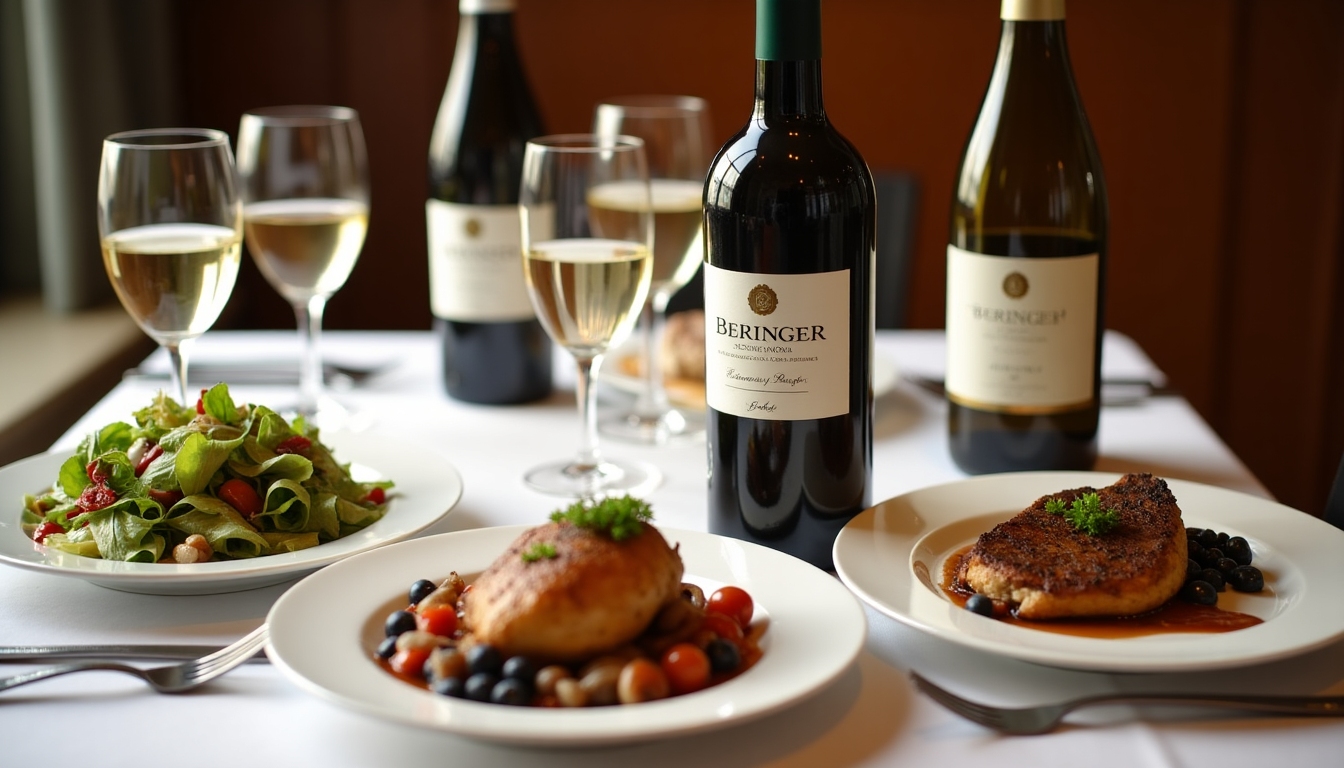Pairing Wine with Food: Tips and Tricks
Pairing wine with food is an art that can elevate your dining experience. It's about finding the perfect balance between the flavors of the wine and the dish. In this guide, we'll explore tips and tricks to help you master the art of wine pairing, with a special focus on Beringer wines, including the Beringer Merlot tasting guide.

Introduction
Wine has been a companion to food for centuries, enhancing flavors and creating memorable dining experiences. The right wine can complement a dish, bringing out its best qualities, while the wrong choice can overshadow or clash with the food. In this article, we'll delve into the world of wine pairing, offering practical tips and insights to help you make the perfect match. We'll also spotlight Beringer, one of the renowned wine brands, and provide a detailed look at the Beringer Merlot tasting guide.
Basic Principles of Wine Pairing
Understanding the basic principles of wine pairing can make the process less intimidating and more enjoyable. Here are some key concepts to keep in mind:
-
Match the Weight: Pair light wines with light dishes and full-bodied wines with hearty dishes. For example, a delicate white wine like Sauvignon Blanc goes well with a light salad, while a robust red like Cabernet Sauvignon complements a grilled steak.
-
Consider the Flavors: Look for complementary or contrasting flavors. Complementary pairings enhance similar flavors, such as a buttery Chardonnay with lobster. Contrasting pairings balance different flavors, like a sweet Riesling with spicy Thai food.
-
Acidity and Fat: High-acid wines can cut through rich, fatty foods. A crisp white wine like Pinot Grigio pairs beautifully with creamy pasta dishes.
-
Tannins and Protein: Tannic wines, which have a slightly bitter taste, pair well with protein-rich foods like red meat. The proteins soften the tannins, creating a harmonious balance.

Spotlight on Beringer Wines
Beringer is one of the most respected wine brands, known for its quality and consistency. Founded in 1876, Beringer has a long history of producing exceptional wines from California's Napa Valley. Among their offerings, the Beringer Merlot stands out for its rich flavor profile and versatility in pairing.
Beringer Merlot Tasting Guide: - Flavor Profile: Beringer Merlot is known for its notes of plum, cherry, and a hint of spice, with a smooth, velvety finish. - Pairing Suggestions: This wine pairs wonderfully with roasted chicken, pasta with tomato sauce, or even a hearty beef stew. The fruit-forward flavors complement the savory notes of these dishes, while the smooth tannins provide a pleasant contrast.
Beringer also offers a range of other wines, each with unique characteristics: - Beringer Chardonnay: A buttery, full-bodied white wine that pairs well with seafood or creamy dishes. - Beringer Cabernet Sauvignon: A bold red with high tannins, perfect for red meat or aged cheeses. - Beringer Pinot Noir: A lighter red with earthy notes, ideal for mushroom dishes or salmon.

Tips and Tricks for Successful Wine Pairing
While the principles above provide a solid foundation, here are some additional tips and tricks to enhance your wine pairing skills:
-
Trust Your Palate: Guidelines are helpful, but personal preference is key. If you enjoy a particular pairing, that's what matters most.
-
Experiment: Don't be afraid to try new combinations. You might discover a surprising match that becomes a favorite.
-
Consider the Sauce: Sometimes, the sauce or seasoning of a dish is more important than the main ingredient. For example, a chicken dish with a rich, creamy sauce might pair better with a white wine than a red.
-
Temperature Matters: Serve wines at the right temperature to bring out their best flavors. Reds are typically served slightly below room temperature, while whites are chilled.
-
Avoid Common Mistakes: Be cautious with very sweet wines and spicy foods, as the sweetness can intensify the heat. Also, avoid pairing tannic wines with delicate fish, as the tannins can overpower the subtle flavors.
Here's a quick reference table for some common wine and food pairings:
| Wine Type | Food Pairings |
|---|---|
| Sauvignon Blanc | Light salads, goat cheese |
| Chardonnay | Lobster, creamy pasta |
| Pinot Noir | Salmon, mushroom dishes |
| Merlot | Roasted chicken, pasta with tomato sauce |
| Cabernet Sauvignon | Grilled steak, aged cheeses |

Personal Insights and Experiences
One of my most memorable wine pairing experiences was at a dinner party where I served a Beringer Merlot with a hearty beef stew. The wine's rich, fruity flavors perfectly complemented the savory, slow-cooked beef, and the smooth finish lingered pleasantly on the palate. It was a hit with all the guests, and it taught me the importance of matching the weight and intensity of the wine with the dish.
Another lesson I learned is the value of experimentation. I once paired a Beringer Chardonnay with a spicy Thai curry, and while it wasn't a traditional match, the wine's acidity and slight sweetness balanced the heat beautifully. It was a delightful surprise that encouraged me to think outside the box.
Summary
Pairing wine with food is a delightful way to enhance your dining experience. By understanding the basic principles, experimenting with different combinations, and trusting your palate, you can create memorable meals. Beringer wines, with their diverse range and quality, offer excellent options for pairing with a variety of dishes. Whether you're enjoying a casual dinner or hosting a special event, the right wine can make all the difference.
